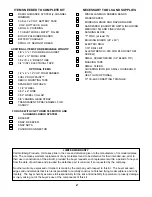
ADHESIVES & GLUING TECHNIQUES
The ELECTRA was designed for fast assembly using
SUPER JET™ CA (cyanoacrylate adhesive), which is spe-
cially formulated to firmly glue the plywood, hardwood, and
balsa used in your model and to withstand vibration.
However, there are times, such as when you are installing the
stabilizer and fin on the fuselage and want more set-up time
for careful alignment and positioning, when you should use
JET EPOXY™. Occasionally, you also will want to use
INTANT JET™, which "wicks" into the surrounding areas.
Aliphatic resin glue or similar water-based glues can also be
used, but they will add to the assembly time because they dry
so much more slowly than SUPER JET™.
WARNING
Never use watery THIN type CA glue for gluing plywood
and hardwood parts. Thin CA's do not adequately bond
these areas.
SUPER JET™ is strongly recommended for most model
building tasks because, when pressed into a very thin layer, it
sets almost instantly. After the initial bond, SUPER JET™
continues to strengthen. However, because of SUPER
JET's™ quick set-up, you must be careful to read instruc-
tions thoroughly, as you will have only seconds for positioning
of parts. Be sure to trial fit parts together before gluing.
SUPER JET™ is used in two general ways. One is to
apply the CA to one part and then press the two parts to be
glued together. Or, you can position parts in contact and then
run SUPER JET™ into the joint. As it seeps into the joint, it
will leave a slight reinforcing fillet. If you don't see a slight fil-
let, the CA has soaked into the wood edges and a second
coat is needed.
SUPER JET™ sets up a bit slower with plywood and
other harder woods, so hold such parts together a little longer
than you would for balsa. Corner fillets take even longer to dry
because there is a thick layer. To speed up such slow drying
joints, use JET SET™, an accelerator for all brands of CA
glue. JET SET™ bridges greater gaps, speeds up slow
bonds, and provides strong glue joint fillets.
Epoxy glues come in two parts which need to be mixed
before using. When buying epoxy, check to see how long the
glue takes to set. We recommend either JET 6 MINUTE
EPOXY™ or JET 20 MINUTE EPOXY™. Disposable wood
strips, cotton swabs, cheap stiff bristle brushes or acid brush-
es from auto stores make good applicators. Because epoxy
is so thick, it is easy to apply too much. Use sparingly, espe-
cially when assembling the fin, stabilizer, and wings.
CAUTION.
Some people may experience an allergic
reaction when exposed to fumes from CA glue or epoxy. As
with paints, thinners, and solvents, it is always important to
use glues only where there is adequate ventilation to carry
fumes away. A fan is recommended. Also, special care must
be taken when using CA, as it will bond skin as well as other
surfaces. JET DE-SOLV™ is a CA solvent which removes
hardened glue from fingers and softens glued joints for repo-
sitioning. Before using any CA, carefully read all label pre-
cautions. When using CA, protective eye-wear and care in
keeping the glue away from the face is highly recommended.
If CA does happen to get into the eye, hold lid open and flush
with water only. Seek immediate medical attention.
CHOOSING A RADIO
IMPORTANT: When selecting a radio, remember that
there are many radio frequencies available, but not all of
these frequencies can be used legally to operate model air-
planes. Be sure to tell your dealer that you want a radio with
a "Model Airplane" frequency.
Although the
ELECTRA
is designed to fly on 2 or 3-
channel radio equipment, we recomend you purchase at
least a 4-channel radio with 3 servos. This will be more
useful, if later you wish to move up to more sophisticated
aircraft.
4





































